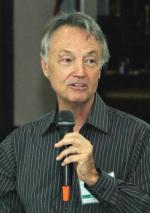The Engineer, Teacher, and Teacher Educator
Spring
2017
Spotlight on Hidden Physicists
The Engineer, Teacher, and Teacher Educator
Graham DeVey, Program Manager, Maui Economic Development Board
 “What a bunch of losers! These people gave up good careers to teach high school science?” was my reaction, years ago, while listening to the “Voice of America” radio program on my way to work in Malaysia. I was building an engineering design team at Carrier International’s air conditioning plant near Kuala Lumpur, my first management position.
“What a bunch of losers! These people gave up good careers to teach high school science?” was my reaction, years ago, while listening to the “Voice of America” radio program on my way to work in Malaysia. I was building an engineering design team at Carrier International’s air conditioning plant near Kuala Lumpur, my first management position.
I would have thought it impossible that I’d someday look back on a 17-year career as a physical science teacher.
The “Voice of America” program featured scientists and engineers who’d left their industry or research jobs to become science teachers. They were thriving on the pace and responsibilities of working with young minds. Again and again they shared their enthusiasm. I could tell they weren’t kidding, and a little seed of curiosity, of future challenge, was planted within me.
“Those of us who have seen our science ‘pay off’ in the marketplace, with original products, patents, or research results to our credit, are in a unique position to convince students that, yes, this stuff really works.”
A few years later, I was an engineering executive, finishing 10 years of overseas work. Should I try something new? I was 42, and “Voice of America” was resonating in my brain.
While posted to Carrier’s research center stateside, I earned an MA in teaching physics and was nominated to Sigma Pi Sigma by the faculty chair at the State University of New York (SUNY) at Cortland. I was excited to be back in college classes, catching up with new thoughts and methods. I did practice teaching and wrote a thesis on science motivation that shaped my teaching method.
Our family bought a home on Maui where I planned to teach physics. When we arrived, there were no physics positions, just a 9th grade science job in a large, downtown school. One woman had applied for the job but backed out, so the job was mine.
The school was old and respected, serving a large, stable neighborhood. Our science department was accomplished, collegial, and skilled. I launched into my classes, sharing ideas with hundreds of youngsters each year. I taught physical science for 17 years, at a job and school another teacher had rejected.
Professionals like many of us Sigma Pi Sigma alumni, with life experience pursuing and applying physics outside the world of academia, have an important place in America’s classrooms. Often, teachers attend college and bounce straight to the classroom without hands-on, daily work experience. Those of us who have seen our science ‘pay off’ in the marketplace, with original products, patents, or research results to our credit, are in a unique position to convince students that, yes, this stuff really works.
I recently encountered a former student who now holds an engineering degree and a good job. He shook my hand and told me, “I had more eureka moments in your class than in any college course.” I’m grateful for my 20-year success as an engineer, and 17 rewarding years teaching in high school.
A physics background gives people like us the opportunity to pursue career choices. When I finished teaching at age 62, I took a full-time job with a nonprofit, Maui Economic Development Board, and now I travel Hawaii teaching inquiry methods to hundreds of public science teachers each year. Perhaps I’ve planted an idea with some of our Sigma Pi Sigma readers—think about joining me in the classroom!
